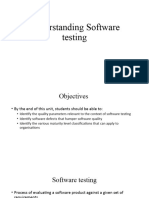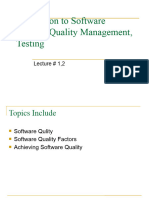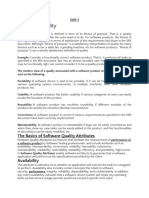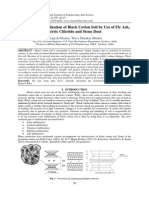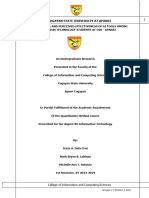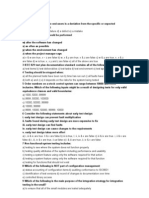Research Inventy: International Journal of Engineering and Science
Research Inventy: International Journal of Engineering and Science
Uploaded by
inventyCopyright:
Available Formats
Research Inventy: International Journal of Engineering and Science
Research Inventy: International Journal of Engineering and Science
Uploaded by
inventyOriginal Title
Copyright
Available Formats
Share this document
Did you find this document useful?
Is this content inappropriate?
Copyright:
Available Formats
Research Inventy: International Journal of Engineering and Science
Research Inventy: International Journal of Engineering and Science
Uploaded by
inventyCopyright:
Available Formats
Research Inventy: International Journal Of Engineering And Science Vol.
3, Issue 10 (October 2013), PP 37-46 Issn(e): 2278-4721, Issn(p):2319-6483, Www.Researchinventy.Com
A Generalized Quality Model for Localized Software Product
1
1
Manisha Bhatia, 2Aparna Sharma
(Assistant Professor, Computer Science, Banasthali Vidyapith, Jaipur) 2 (M.Tech. Scholar, Computer Science, Banasthali Vidyapith, Jaipur)
ABSTRACT : There are a number of quality model already available like MC.Call Quality model, Boehm
Quality model, ISO 9126, Capability maturity model and LISA(Localisation Industry standard association ) has also introduced its own QA model. Each model is adapted by several organizations in some way to manage the quality assurance process for the components in the product. The purpose of this paper is to simulate some of the already existing QA models with regard to the localized product and to introduce a new Generalized QA model combining the advantages of several. It also discusses the QA model with an example of the tester module named GUNVATTA PARIKSHAK and identifies the value metric for each of the operation.
KEYWORDS: Boehm, CMM, Furps, ISO, LISA, Mc-Call I. INTRODUCTION
1.1. Quality Quality is a measurable characteristic or attributes in comparison to the standards. It is a state of being free from defects, deficiencies and significant variations. Quality of design refers to the characteristics that software designers specify for a product and Quality of conformance is the degree to which the design specifications are followed during development. For a localized product it will be evaluated as:User satisfaction = compliant product + good quality + delivery within budget and schedule 1.2. Quality Control Quality control involves the series of inspections, reviews, and tests used throughout the software process to ensure each work product meets the requirements placed upon it. 1.3. Quality Assurance The goal of quality assurance is to provide developer with the data necessary to be informed about software quality, thereby gaining insight and confidence that product quality is meeting its goals. 1.4. Software Quality Assurance Conformance to explicitly stated functional and performance requirements, explicitly documented development standards, and implicit characteristics that are expected of all professionally developed software. Wikipedia defines Software Quality assurance (SQA) as It consists of a means of monitoring the software engineering processes and methods used to ensure quality. The methods by which this is accomplished are many and varied, and may include ensuring conformance to one or more standards but for Localized software product its Quality Assurance verifies that the released localized product can accurately deliver its intended function to its end users. There are a number steps that may be included in QA of a localized product like [1] Setting up the build environment. [2] Compiling or building the localized application. [3] Acquiring the hardware/software and setup needed to run the application. [4] Acquiring application and test plan learning curve familiarity. [5] Generating and adopting the formal QA plan with team buy-off. [6] Implementing the QA plan in runtime according to plan. [7] Applying any localization changes where necessary, together with any engineering changes required by localization. [8] Rebuilding the corrected application.
37
A Generalized Quality Model
[9] Verifying corrections. [10] Generating a final QA report 1.5. Software Quality Assurance Activity Software quality assurance is composed of a variety of tasks associated with two different constituenciesthe software engineers who do technical work and an SQA group that has responsibility for quality assurance planning, oversight, record keeping, analysis, and reporting. These activities are performed by SQA group that:Prepares a SQA plan for project Participates in the development of the projects software process description Reviews software engineering activities to verify compliance with the defined software process Audits designated software work products to verify compliance with those defined as part of the software process Ensures that deviations in software work and work products are documented and handled according to a documented procedure Records any noncompliance and reports to senior management
II.
EVALUATING KEY PERFORMANCE INDICATORS FOR SOFTWARE EVALUATION
Key performance indicator is a type of measurement in performance to achieve operational goal to achieve zero defects in localized product or 100% customer satisfaction. Performance of a localized product should be measured against goals such as boosting the profitability of international operations, Grabbing share from competitors, improving customers loyalty, increasing li fetime value of customers and pumping up brand awareness in target regions. Table 1 Impact of bad localization or not localizing a software product Marketing Limited reach of marketing programs customers dont know what were selling Sales Sales are limited to those who are comfortable in the nuances of the specific language; incomplete transactions Support Frustrated customers; bad reputation for usability; brand damage; higher support costs; expensive problem resolution through call centers
III.
VARIOUS EXISTING QUALITY ASSURANCE MODELS
3.1.Mc Call Software Quality Model Adopted for Localized Product It attempts to bridge the gap between the local users and the developers of the localized product. Software quality factors that reflects the users views and the developers priorities. Local Product Revision (ability to undergo changes) a. Maintainability: - the effort required to locate and fix a fault in the local product . b. c. Flexibility:-The ease of making changes required by the changes in the product acc. To the target market and customer. Testability:-Testing the local product based on various quality criterias and to ensure that it meets its specification and the requirement of the local people
38
A Generalized Quality Model
3.2. Local Product Transition (adaptability to the local market) a. Portability: - Effort required transferring the product from one local market to another with some minor changes. b. Reusability:-The ease of reusing the software in some different context. For ex. A Localized software product that sells Burger can be used for selling Vada Pav for other region. c. Interoperability:- The effort required to couple a localized system with other localized system. 3.3. Local Product Operations:- (its operation characteristics) a. Correctness:-The extent to which a local product fulfills its specification and requirements of local people. b. Reliability: - The local systems ability not to fail and the information provided must be reliable acc. To the local market. c. Efficiency:-the use of resources (like processor time, storage etc. ) that are required by the local product. May be further categorized as Execution efficiency and Storage efficiency. d. Integrity:-Protection of the Localized product for unauthorized access with passwords, digital signature etc. e. Usability:-The ease of learning and using the software by the local people.
Figure 1: The McCall quality model (a.k.a. McCalls Triangle of Quality) organized around three types of quality characteristics. All these factors of Mc. Call quality model can be adopted for localized software but with varying degree of acceptance. Table 2 Quality factors of Mc Call quality model and their priority in requirements when adopted for a localized software product
Quality Factors Sub categorization Maintainability Flexibility Testability Local Transition Product Portability Reusability Interoperability Local Operations Product Correctness Reliability Efficiency Integrity Usability Highly Required Required Required but acceptable with minor changes
Local Product Revision
39
A Generalized Quality Model
3.4. Boehm Software Quality Model for Localized Product This model attempts to qualitatively define the software quality by a given set of attributes and metrics. It presents a hierarchical software quality model structured around high level characteristics, intermediate level characteristics, primitive characteristics each of which contributes to the overall quality level for local products (K.K. Aggarwal and Yogesh Singh 2007). 3.5. High Level Characteristics a. As-is-utility: - How easily, reliably and efficiently a local product can be used as it is. b. Maintainability: - How easy a local product is to understand, modify and retest. c. Portability:- Can a local product can be used if the environment is changed. 3.6. Intermediate Level characteristics a. Portability:-A local product can be adapted and operated easily on different computer configuration. b. Reliability:-A local product either performs its expected intended function satisfactorily or not. c. Efficiency:-A local product is fulfilling its purpose without waste of its resources. d. Usability:-Ease of use of a local product for its local customer. e. Testability: - It facilitates the establishment of verification criteria and supports evaluation of its performance. f. Understandability: - Ease of learning and understanding the purpose of the localized product for its intended local customer. g. Flexibility:-Incorporation of changes once the nature of the desired changes in the local product is determined. Table 3 Quality factors of Boehm Quality model and their priority in requirements when adopted for a localized software product Quality Factors As is utility Sub categorization Reliability Efficiency Usability Maintainability Testability Understandability Flexibility Portability ----Highly Required Required Required but acceptable with minor changes
3.7. LISA Quality Assurance Model 3.1 The Localized industry Standard Association (LISA) designed a quality assurance model for all the components in a localized product in terms of its functionality, documentation and language issues. It can be implemented as a standalone application and can be easily integrated into any system that supports ODBC database connectivity (LISA QA model 3.1).It provides a number of features to the users of LISA QA model
40
A Generalized Quality Model
Figure 2: Snapshot of quality model given by LISA 1.1.1. It tests all error messages and severity levels in a single click and results in showing the status in PASS/FAIL 1.1.2. Single interface provides access to all like data recording, reporting, adding new projects etc. 1.1.3. It has example data that help users in their implementation after testing the quality of the software. 1.1.4. Metrics for evaluation of the source documents. 1.1.5. QA data can be protected against deletion, alteration etc. 1.1.6. User portable database scheme can be implemented in user own database engine. 1.2. Capability Maturity Model for Localized Product CMM is a strategy for improving software process, irrespective of the actual life cycle model used. It can be used to judge the maturity of the localized software process and to identify the key practices that are required to increase the maturity of these processes. CMM maturity model is organized into five maturity levels:-
Figure 3: Maturity levels of Capability maturity model Other than all these there are other quality models( like ISO 9126,Furps/FURPS+,Dromeys quality model etc.) each with their advantages and disadvantages. IV. GENERALIZED QUALITY MODEL FOR LOCALIZED PRODUCT
Figure 4: A summarized view of Quality Assurance model for localized product
41
A Generalized Quality Model
The Fig 5 represents a complete quality model for localized software combining advantages of various quality models like 1.2.1. 1.2.2. a. b. c. d. e. 1.2.3. It uses the maturity levels of Capability maturity model It has hierarchical quality model structured around 5 levels i.e. Product Identification Product Categorization Product Consideration Product Operation Product Optimization It determines both qualitative as well as quantitative factors.
Figure 5: Generalized quality model adopted for localized product with advantages of Mc Call, Boehm, CMM, Furps, and ISO 9126 There are also quality model builder tool readymade available in the market that can create your own quality model like for creating a quality model in the form of a tree we need to provide the tool with information as its Name, priority, Relative ordering etc. and then we can have the result as Relative importance, Maximum value of node, Normalized result Rating level
42
A Generalized Quality Model
1.3. Localizability: - The ability of a computer software program that can be converted to any specific or general local language according to its local culture with local look n feel. 1.3.1. Functionality:-The expected functions and features for which the local product is designed are either fulfilled or not. a. Suitability :- The extent to which a local product is suitable for the particular local market [1] Correctness: - The extent to which a local software meets its specification. [2] Completeness:-The extent to which a local software product is Complete with regard to its functionality and its look n feel. [3] Acceptability (For optimizing it, needs to be maximize):-The extent to which it is expected to be accepted by its local customers. b. [1] [2] c. [1] [2] Reliability:-The extent to which the local software performs its intended function without failure. Accuracy( For optimizing it , needs to be maximize):- The extent to which information provided in the local system is accurate and reliable Error Tolerance:-The amount of error that can be tolerated by the system. Interoperability:-The effort required to couple a localized system with other localized system. Terms Commonality:-Integration of two localized system based on the extent to which terms are common in both the system. Graphics Commonality:-Integration based on the common features in look n feel of both products according to the local market. Integrity:-The protection of the software program from unauthorized access. Access Control:-Controlling the access by specifying access privilege to the customers of the local product with login passwords or digital signatures etc. Security/Accessibility: - Securing the software in case of power failure and authentication of its customer. Adaptability:-The extent to which local product is adaptable to the local environment, people, technology and platforms. Acceptance:-The extent to which the local product is expected to be accepted by the local customer. Terminology Testing: - The extent to which the terms used in the local product matches with its regional locale. Linguistic Testing:-Checking for the context in which the specific term used and its language suitability. Cosmetic Testing:-Testing the look n feel of the local product in accordance to the local market and local customers. Usability:-The extent of the effort required to learn operate and understands the functions of the local software.
d. [1] [2] e. [1] [2] [3] [4] [5]
1.3.2. Supportability:-The extent to which the software product supports various features like its maintainability, portability, flexibility etc. a. Maintainability:-The effort required locating and fixing errors in the software as a part of maintaining the system. [1] [2] [3] [4] b. [1] [2] [3] Self-Descriptiveness:-The extent to which system specifies itself with help or easy to use menus and terms, so that it can be learned and used by the local customer easily. Testability:-The effort required to test the localized system to ensure that it performs its intended function without bugs n errors. Understandability:-The effort required to learn the local system so that its purpose is clear to its customer. Usability:-The effort required to learn, operate and to understand the local system by its users. Portability:-The extent to which a local system can be transferred from one platform to other. Device Independence:-The extent to which a local system is independent to its device on which it is running. Installability:-The easiness of the local software product to be installed on different platforms with differing technologies. Compatibility:-The ease of using the local product with different computer system architectures.
43
A Generalized Quality Model
c. Flexibility:-Modifiability of the local software to the extent that it facilitates the incorporation of changes. [1] Expandability:-The effort required expanding the features and functions of the local system. [2] Generality:-The extent to which the code and features of the specific local system can be used for general localized system. [3] Reusability:-The extent to which the code can be reused in some different local system. To test the quality model on a tester module we have a quality tester module named Gunvatta Parikshak that takes as input an application and tests it based on various criterias like terminology testing, acceptance testing, cosmetic testing, effectiveness testing etc. Note: - We will use GP as an acronym for Gunvatta Parikshak Table 4 Description of Product operations with respect to Gunvatta Parikshak Localisation tool
Basis Correctness Description when applied on Gunvatta Parikshak Whether the application GP tests the input a pplications terms ,its look n feel according to the local market or not . It is correct if it checks all the criteria which are specified and for which it is designed. GP tests the application based on various basis and results in many artifacts showing the completeness of the application. GP checks at what extent the input application is acceptable by its local customer. GP checks at what extent the information provided in the input local application is according to its locale. GP checks how much errors and bugs the input application can tolerate when adapted in a new local environment. When there is a need to interoperate two different local applications then GP checks that how many terms in total are common in both the local application to make it easy to integrate. When there is a need to interoperate two different local application then GP checks that how much similarities are there in graphics of both the application GP checks for privileges that are being provided to the users or customers of the local application. GP checks for the level of security for the local application , security in the case of power failure, authentication etc. GP checks the terms that is being used in the local product are how much correct with regard to its original version. GP checks for the context of the language used in the local product, whether the terms are right according to the context in which they are being used. GP checks for the cosmetic i.e. look n feel of the local product. At what extent it is according to the local culture and people. GP checks for the effort required to learn the input local application whether it is expected to take an hour, a day or may be more or training required or not. Values Obtained* Values lies between 3 and 4
Completeness
Values lies between 3 and 4
Acceptability
Values lies between 4 and 5
Accuracy
Values lies between 4 and 5
Error Tolerance
Values lies between 3 and 4
Terms Commonality
Values lies between 3 and 4
Graphics Commonality
Values lies between 3 and 4
Access Control
Values lies between 3 and 4
Security
Values lies between 3 and 4
Terminology
Values lies between 4 and 5
Linguistic
Values lies between 3 and 4
Cosmetic
Values lies between 4 and 5
Usability
Values lies between 4 and 5
44
A Generalized Quality Model
SelfDescriptiveness Testability At what extent the local software descript itself in form of help, tutorials , tooltips etc. GP checks how efficiently the system can be tested like in how much time without having any bugs or errors. GP identifies the percentage value at which the local system is understandable by the local customer. GP checks the local product whether it is independent of the device on which it is installed or not, and if yes then at what extent it is. GP checks how easily the local software can be installed on the different platform like how much space, effort and time it requires to install. GP checks for how much the input local application is compatible with different computer system architecture like the processor, RAM, OS, Memory that is being required. GP identifies how easily the local product can be expanded in a new version, or it may be how easily the features and functionality of the local product will be enhanced. GP identifies the percentage value for the local product for being its general (i.e. being adapted for other local product) and for being its specific for the current locale. GP identifies the amount of the code that can be reused (like 10% or 20% etc.) in designing or maintaining some other or same local application. Values lies between 3 and 4
Values lies between 2 and 3
Understandability
Values lies between 4 and 5
Device Independence
Values lies between 1 and 2
Installability
Values lies between 3 and 4
Compatibility
Values lies between 1 and 2
Expandability
Values lies between 4 and 5
Generality
Values lies between 3 and 4
Reusability
Values lies between 2 and 3
*These values obtained are with respect to Gunvatta parikshak localization tool. Here number represents 1- very low, 2- low, 3 - neither low nor high, 4 - high, 5 very high.
Figure 6: Priority values for Product Operations with regard to Gunvatta Parikshak
V.
CONCLUSION
The above paper presents a generalized quality model in both a summarized and detailed view that combines the advantages of various existing quality model adopted for localized product, as it considers quantitative factor of Mc-Call quality model and qualitative factor of Boehm software quality model. From Fig 6 we can conclude that for Generalized quality model for localized product higher priority factors are its Correctness, Acceptability, Accuracy, Terminology, Cosmetic, Usability, Understandability and its
45
A Generalized Quality Model
Expandability and the other factors like portability, Install ability, Integrity are with lower priorities i.e. they are required but acceptable with minor changes. The paper presents various quality factors of product operations with the help of a quality tester module name Gunvatta Parikshak that specifies them together with the corresponding value metric that ranges from very low to very high.
REFERENCES
[1] [2] [3] K.K. Aggarwal & Yogesh Singh , Software Engineering (3rd ed., 2007, New Age International Publishers) Roger S. Pressman, Software Engineering (5th ed. 2000 McGraw-Hill Higher Education Publishers) Software Quality models and philosophies, [Online] http://www.bth.se/com/besq.nsf/(WebFiles)/CF1C3230DB425EDCC125706900317C44/$FILE/chapter_1.pdf(Accessed 19thSep 2013) LISA QA Model 3.1 -- Assisting the localization development, production and quality control processes for global product distribution,[Online], http://dssresources.com/news/1558.php Localisation Quality Assurance -How Important?,[Online], http://www.globalvis.com/localization-qa- Dan Johnson The Guide for multilingual computing and technology LOCALISATION July -Aug 2003 , 18-20,[Online] http://www.multilingual.com/downloads/screenSupp57.pdfhow-important/
[4] [5]
46
You might also like
- UI UX PlaybookDocument19 pagesUI UX PlaybookLohith R43% (7)
- Project Report On ATM SystemDocument56 pagesProject Report On ATM SystemKumar Siva72% (116)
- Online Restaurant Table ReservationDocument7 pagesOnline Restaurant Table ReservationKALEEM75% (4)
- Cap3104 Presentation TemplateDocument25 pagesCap3104 Presentation Templateapi-560112758No ratings yet
- Test Strategies For Mobile Device ApplicationsDocument24 pagesTest Strategies For Mobile Device ApplicationsShamini SubramaniamNo ratings yet
- Se Module 5 Answer QbankDocument32 pagesSe Module 5 Answer QbankSunil MSNo ratings yet
- SE MODULE 5 ANSWER QBANK MergedDocument30 pagesSE MODULE 5 ANSWER QBANK MergedSunil MSNo ratings yet
- Module 5Document36 pagesModule 5rnitotest1No ratings yet
- SQM-Unit1 and Unit 2Document103 pagesSQM-Unit1 and Unit 2Gopikrishnan MurugesanNo ratings yet
- Software - Engg Chap 05.4Document25 pagesSoftware - Engg Chap 05.4mylove6947No ratings yet
- Part 1Document18 pagesPart 1u2203162No ratings yet
- Software Quality ManagementDocument22 pagesSoftware Quality ManagementnarainzNo ratings yet
- SQM P.selvapriyavadhanaDocument35 pagesSQM P.selvapriyavadhanaVishu AsensioNo ratings yet
- Assignment-6Document24 pagesAssignment-6jayesh tahasildarNo ratings yet
- SQM NotesDocument10 pagesSQM Noteswwwguna939No ratings yet
- Module 7Document5 pagesModule 7nadiahraisNo ratings yet
- Software Engg Week 11 Quality + TestingDocument51 pagesSoftware Engg Week 11 Quality + TestingIbrahim QamarNo ratings yet
- Winter Semester 2023-24 - CSE1005 - ETH - AP2023246001106 - 2024-04-26 - Reference-Material-IDocument29 pagesWinter Semester 2023-24 - CSE1005 - ETH - AP2023246001106 - 2024-04-26 - Reference-Material-IDishitha Reddy PakalaNo ratings yet
- Chapter 19 Quality ConceptsDocument28 pagesChapter 19 Quality Conceptssuleman ahmedNo ratings yet
- SQE Assigment1Document5 pagesSQE Assigment1Noor-Ul AinNo ratings yet
- Understanding Software TestingDocument37 pagesUnderstanding Software Testingemmarvelous11No ratings yet
- Lecture 03Document33 pagesLecture 03yasas broNo ratings yet
- Submitted To:Engr Wajeeha Batool Submitted By:Sameer Hani DATE:14-09-2023Document5 pagesSubmitted To:Engr Wajeeha Batool Submitted By:Sameer Hani DATE:14-09-2023Engr Sameer HaniNo ratings yet
- Week 13 Lecture # 1Document56 pagesWeek 13 Lecture # 1hs5849377No ratings yet
- Software Engineering - Full - NotesDocument85 pagesSoftware Engineering - Full - NotesLeslie QwerNo ratings yet
- SQE Week 1 LectureDocument52 pagesSQE Week 1 LectureJavaria tanveer100% (1)
- Sqa Unit 1 PDFDocument49 pagesSqa Unit 1 PDFAnuja GanjikarNo ratings yet
- By Naresh Kummari CSU ID # 900682741Document25 pagesBy Naresh Kummari CSU ID # 900682741Naresh KNo ratings yet
- Se - Unit - IvDocument17 pagesSe - Unit - IvPoonamNo ratings yet
- Unit 2Document19 pagesUnit 2mastersin2022No ratings yet
- University of Lahore: Department of Software EngineerDocument3 pagesUniversity of Lahore: Department of Software EngineerHannan ButtNo ratings yet
- Unit 1Document35 pagesUnit 1sivamuruganvelmurugaNo ratings yet
- Software Quality AssuranceDocument9 pagesSoftware Quality Assurancealhassan007No ratings yet
- SQM NotesDocument164 pagesSQM NotesASGNo ratings yet
- Introduction To Software QualityDocument49 pagesIntroduction To Software QualityVasila BegamNo ratings yet
- Software EngineeringDocument24 pagesSoftware Engineeringᴄᴏꜰꜰɪɴ17No ratings yet
- pm_chapter07_1_0_0Document28 pagespm_chapter07_1_0_0alnahary1No ratings yet
- Se Key PaperDocument11 pagesSe Key Paperpeddaboina yamuna ramNo ratings yet
- Software Engineering: Slide Set 07: Software Quality AssuranceDocument32 pagesSoftware Engineering: Slide Set 07: Software Quality AssuranceUmar MalikNo ratings yet
- Software Quality Requirements and Factors-3Document29 pagesSoftware Quality Requirements and Factors-3karinardhaniNo ratings yet
- 2.1 Software Process ModelDocument3 pages2.1 Software Process ModelDaniel CabasaNo ratings yet
- Unit-1 SQEDocument16 pagesUnit-1 SQEGamer BhagvanNo ratings yet
- Software Engineering solveDocument5 pagesSoftware Engineering solveatrange001No ratings yet
- Process Framework Model and Phases in Software DevelopmentDocument26 pagesProcess Framework Model and Phases in Software DevelopmentAkash T MNo ratings yet
- SE MODLUE 5 NotsDocument9 pagesSE MODLUE 5 NotsBhargaviNo ratings yet
- Unit1-SQT 2Document11 pagesUnit1-SQT 2zulekhagaffar65No ratings yet
- Science - BSC Computer Science - Semester 5 - 2022 - November - Elective I Software Testing and Quality Assurance CbcsDocument22 pagesScience - BSC Computer Science - Semester 5 - 2022 - November - Elective I Software Testing and Quality Assurance CbcsmontysirrotNo ratings yet
- Unit 4Document140 pagesUnit 4vinaypatidar2424No ratings yet
- Block III: From Architecture To Product: Unit 11: Product Quality: Verification, Metrics and TestingDocument71 pagesBlock III: From Architecture To Product: Unit 11: Product Quality: Verification, Metrics and TestingChristina FingtonNo ratings yet
- Se 5Document38 pagesSe 5ahmedshamil4567No ratings yet
- Stqa SamaDocument110 pagesStqa SamaAbhay PawarNo ratings yet
- Software QualityDocument45 pagesSoftware QualityBiplab BiswasNo ratings yet
- SQM AssignmentDocument13 pagesSQM AssignmentJagmeet SinghNo ratings yet
- Introduction and Basic of Software ModellingDocument19 pagesIntroduction and Basic of Software ModellingtruptiNo ratings yet
- Software Questions N AnsDocument3 pagesSoftware Questions N Ansphronesisquansah3No ratings yet
- Softengg Da1Document9 pagesSoftengg Da1shreemanjulaaNo ratings yet
- Jaminan Kualitas Perangkat Lunak (Software Quality Assurance) (4616432) - 3 SKSDocument13 pagesJaminan Kualitas Perangkat Lunak (Software Quality Assurance) (4616432) - 3 SKSDiah RistantiNo ratings yet
- Software Quality AttiributesDocument27 pagesSoftware Quality AttiributesnazranaNo ratings yet
- FALLSEM2023-24 SWE2020 ETH VL2023240103291 2023-11-20 Reference-Material-IDocument22 pagesFALLSEM2023-24 SWE2020 ETH VL2023240103291 2023-11-20 Reference-Material-IKartik SoniNo ratings yet
- SE NotessDocument15 pagesSE NotessNidhin EdappalNo ratings yet
- Software Quality ManagementDocument104 pagesSoftware Quality Managementdhiraj_niceNo ratings yet
- Testing Practitioner Handbook: Gain insights into the latest technology and business trends within testing domains.From EverandTesting Practitioner Handbook: Gain insights into the latest technology and business trends within testing domains.No ratings yet
- Software Testing Interview Questions You'll Most Likely Be AskedFrom EverandSoftware Testing Interview Questions You'll Most Likely Be AskedNo ratings yet
- Real-World Solutions for Developing High-Quality PHP Frameworks and ApplicationsFrom EverandReal-World Solutions for Developing High-Quality PHP Frameworks and ApplicationsRating: 2.5 out of 5 stars2.5/5 (2)
- A Study of Automated Decision Making SystemsDocument4 pagesA Study of Automated Decision Making Systemsinventy100% (1)
- Choice of Numerical Integration Method For Wind Time History Analysis of Tall BuildingsDocument10 pagesChoice of Numerical Integration Method For Wind Time History Analysis of Tall BuildingsinventyNo ratings yet
- Biodiversity Hotspots of Magnolia Species in ChinaDocument4 pagesBiodiversity Hotspots of Magnolia Species in ChinainventyNo ratings yet
- Lean Construction - Approach Capable of Dealing With Complexity and UncertaintyDocument8 pagesLean Construction - Approach Capable of Dealing With Complexity and UncertaintyinventyNo ratings yet
- A Study On Stabilization of Black Cotton Soil by Use of Fly Ash, Ferric Chloride and Stone DustDocument6 pagesA Study On Stabilization of Black Cotton Soil by Use of Fly Ash, Ferric Chloride and Stone DustinventyNo ratings yet
- Qnix 8500 Data SheetDocument10 pagesQnix 8500 Data SheetMustafa BahtiyarNo ratings yet
- Critical Success Factors For Enterprise SearchDocument9 pagesCritical Success Factors For Enterprise Searchcrystalia diamondaNo ratings yet
- SDP Project ProposalDocument6 pagesSDP Project ProposaluocboyNo ratings yet
- UX Interview - Make Sure You Can Answer These 11 UX Design Interview Questions - CareerFoundryDocument8 pagesUX Interview - Make Sure You Can Answer These 11 UX Design Interview Questions - CareerFoundryNunyaNo ratings yet
- Epri Substations - Program 37Document37 pagesEpri Substations - Program 37drjonesg19585102No ratings yet
- Your Lean StartupDocument44 pagesYour Lean StartupTom LowNo ratings yet
- Hacked by WifeDocument4 pagesHacked by WifetestusrNo ratings yet
- Justinmind Prototyper TutorialsDocument50 pagesJustinmind Prototyper Tutorialsnadia_22am5230100% (1)
- Designing Motivational Games For Stroke RehabilitationDocument6 pagesDesigning Motivational Games For Stroke RehabilitationSudipta PradhanNo ratings yet
- Cyber Hacking BreachesDocument4 pagesCyber Hacking Breacheskmp pssrNo ratings yet
- Project Control Book: Project Information Links To Key SVC ProvidersDocument40 pagesProject Control Book: Project Information Links To Key SVC Providersdiana navarroNo ratings yet
- Hcde 417 Group 3 Final ReportDocument52 pagesHcde 417 Group 3 Final Reportapi-438902431No ratings yet
- ETHOS EASY-brochureDocument8 pagesETHOS EASY-brochureMichael MichaelidesNo ratings yet
- Bruker Q4 TASMAN BrochureDocument4 pagesBruker Q4 TASMAN BrochureHoàng HàNo ratings yet
- Qu Stion AreDocument3 pagesQu Stion AreNg MharieNo ratings yet
- Practices, Usage and Perceived Effectiveness of AI Tools Among IT Students of CSU-ADocument48 pagesPractices, Usage and Perceived Effectiveness of AI Tools Among IT Students of CSU-Aantoniomichelleann94No ratings yet
- 5.0 Idea Execution 5.1 Brief Description of Idea Execution Activities: Creating A Brochure For Poster Design Using CanvaDocument10 pages5.0 Idea Execution 5.1 Brief Description of Idea Execution Activities: Creating A Brochure For Poster Design Using CanvaWawa UdinNo ratings yet
- Factors Influencing Customers To Use Digital Banking Application in Yogyakarta, IndonesiaDocument11 pagesFactors Influencing Customers To Use Digital Banking Application in Yogyakarta, IndonesiaNguyễn Ngọc Đoan DuyênNo ratings yet
- IstqbDocument35 pagesIstqbKanika Gupta0% (1)
- Shop Manegement SystemDocument34 pagesShop Manegement SystemMaster T100% (1)
- Alternative Navigator For Nueva Ecija High SchoolDocument26 pagesAlternative Navigator For Nueva Ecija High SchoolMarkLesterEstrellaMabagosNo ratings yet
- Kano S Theory of Attractive Quality and PackagingDocument33 pagesKano S Theory of Attractive Quality and PackagingAvyno AvynoNo ratings yet
- Product Design & Engineering For Developing A Product, A Start-Up's PerspectiveDocument48 pagesProduct Design & Engineering For Developing A Product, A Start-Up's PerspectiveSuraj KushwahaNo ratings yet
- SystemDocument12 pagesSystemrushikeshwaghmare2006No ratings yet
- UC Santa Cruz Previously Published WorksDocument23 pagesUC Santa Cruz Previously Published Workserica de castroNo ratings yet




















